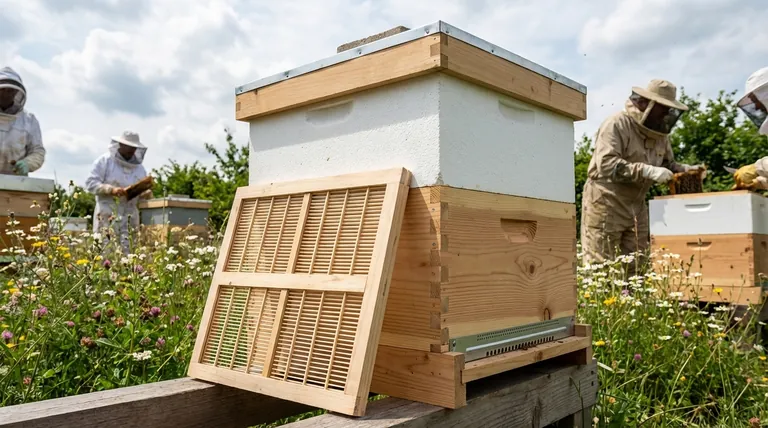In terms of pure thermal insulation, the answer is unequivocally yes. Polystyrene is a vastly more effective insulator than wood, offering anywhere from three to eight times the insulating power for the same thickness. This is because its structure is specifically engineered to trap air and slow the transfer of heat, a task for which wood is not optimized.
While polystyrene is the clear winner for thermal performance, the choice is not that simple. The decision between wood and polystyrene requires understanding that you are often choosing between a dedicated insulator (polystyrene) and a structural material that offers modest insulation (wood).

A Direct Comparison: The R-Value Showdown
To compare insulating materials, we use a metric called R-value, which measures a material's resistance to heat flow. A higher R-value means better insulation.
Polystyrene's Thermal Performance
Polystyrene insulation typically comes in rigid foam boards. Its primary job is to insulate, and it does it very well.
On average, expanded polystyrene (EPS) provides an insulating value of R-4 per inch of thickness. Some high-density or different formulations can offer even higher values.
Wood's Thermal Performance
Wood is a structural building material first and an insulator second. Its dense, fibrous structure conducts heat more readily than foam.
Most common woods have an R-value of approximately R-1 per inch of thickness. This value can vary slightly based on the species of wood and its moisture content.
The Magnitude of the Difference
The numbers speak for themselves. To achieve the same insulating effect as a single one-inch-thick board of polystyrene (R-4), you would need a solid block of wood four inches thick.
This performance gap is why modern construction uses a hybrid approach: a wood frame for structure and a foam or fiberglass insulator to fill the wall cavities for thermal control.
Understanding the Trade-offs: Why Isn't Everything Made of Polystyrene?
If polystyrene is such a superior insulator, it's fair to ask why wood is still used at all. The answer lies in the different roles these materials play.
Structural Integrity
Wood is a structural material. It can bear heavy loads, which is why it's used for framing walls, roofs, and floors.
Polystyrene is not a structural material. It has very low compressive strength and cannot be used to support a building. It serves as a filler, not a frame.
Durability and Application
Projects like beehives highlight this trade-off. A polystyrene hive body is lighter and offers superior insulation, leading to healthier bees. However, it is more susceptible to physical damage than a traditional wooden hive.
Often, the best solution combines both materials—a wooden structure with added polystyrene insulation panels.
Moisture, Fire, and Environment
Wood is a natural, renewable material that can absorb and release moisture. Polystyrene, on the other hand, is a petroleum-based plastic.
While treated with flame retardants, foam insulation will melt when exposed to high heat and can release toxic smoke. Wood chars at a predictable rate, which can sometimes provide more structural stability in a fire.
Making the Right Choice for Your Project
Your optimal material depends entirely on its intended role and your project's primary goal.
- If your primary focus is maximizing thermal insulation in a non-structural space: Polystyrene is the superior choice due to its high R-value per inch, providing the most insulation in the least amount of space.
- If your project requires both insulation and structural support: A hybrid approach is best, using wood for the frame or body and integrating polystyrene panels for thermal control.
- If your priority is using a natural, structural material: Wood is the logical option, but you must account for its lower R-value by increasing its thickness or accepting lower thermal performance.
By understanding each material's core strengths, you can select the right tool for the job and design a system that performs effectively.
Summary Table:
| Material | R-Value per Inch | Primary Use |
|---|---|---|
| Polystyrene | R-4 | Dedicated insulation |
| Wood | R-1 | Structural material with modest insulation |
Need to insulate your beekeeping operation effectively? At HONESTBEE, we supply commercial apiaries and distributors with high-performance materials and equipment. Whether you're building insulated hives or optimizing your setup, our wholesale-focused team can help you select the right solutions for superior thermal management and healthier bees. Contact our experts today to discuss your specific needs!
Visual Guide

Related Products
- Wooden Queen Bee Excluder for Beekeeping
- Professional Plastic Queen Excluder for Modern Beekeeping
- High Performance Plastic Queen Excluder for Beekeeping and Apiary Management
- Langstroth Screen Bottom Board for Beekeeping Wholesale
- Nicot Queen Rearing Kit for Beekeeping and Grafting in Nicot System
People Also Ask
- How does a queen excluder help in finding the queen bee? A Strategic Guide for Commercial Beekeepers
- What are the advantages of using excluders in terms of wax recovery? Maximize Your Yield of Premium Beeswax
- Should queen excluders be used in Flow hives? A Critical Guide for a Clean Harvest
- How should a queen excluder be installed in a beehive? Ensure a Brood-Free Honey Harvest
- What makes polyurethane foam environmentally friendly? The Surprising Benefits of a Durable, Inert Material










